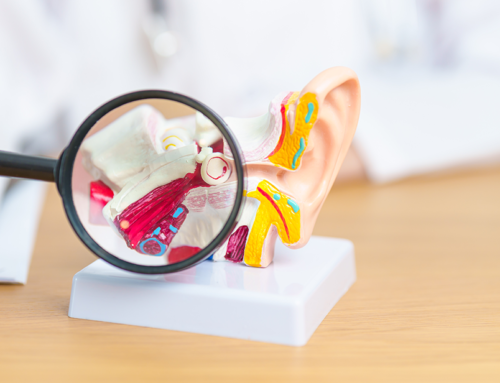What makes hearing implants safe?
While reports of product recalls buzz through the social media groups of hearing implant users, the manufacturers brag about the highest reliability of their products. But what is behind this and what makes hearing implants reliable?

“Children born today will live 120 years!” was the headline in National Geographics magazine back in May 2013. So, if babies are implanted today, their implants should last over a century. But technical devices eventually break down, even the high-quality ones such as hearing implants. How long users can expect them to function properly can be found in the reliability data. For CI candidates and parents, these reliability data are an important decision criterion while they are preparing for the surgery.
ISO standard 5841-2 defines how the reliability of implants must be indicated: this implies to pacemakers as well as hearing implants. The reliability data published according to this standard show how many implants had to be explanted after a certain period of use because they were no longer functional. But, despite this uniform standard, seemingly contradictory information confuses and unsettles users and candidates. Even for experts, this subject is highly complex.
Additionally, there are other factors which have a relevant influence on long-term use with consistent sound quality. The Austrian manufacturer MED-EL even speaks of 360-degree safety and reliability.
Reliability – explained by experts
Prof. Dr. Wolf-Dieter Baumgartner, University Professor at the ENT University Hospital Vienna and Stockholm and a visiting Professor at the University Hospital Brno, is one of the most recognized CI specialists worldwide. He presented current findings on reliability at the Czech ENT Congress in Brno on June 8-10, 2022.
For your convenience, we have combined the information from this presentation with the information from publications of other scientists, with the specifications of the relevant standard, as well as with data from the manufacturers’ websites:
- How implant life has changed over the last decades
- What reliability data means
- How honestly are reliability data presented
- When to change an implant
- How a recall affects users
- Where do manufacturers hide more reliability information
We have summarized the most important criteria for you again.
Experience brings safety
The more sophisticated the system is, the safer it can be guaranteed to function reliably. On the other hand, growing experience in implantation itself also leads to safer surgical procedures and thus to further improved reliability of the intervention. “We have performed 40 percent of our cochlear implantations in the last nine years. From 2013 to 2022, we placed about 100 cochlear implants per year.” Prof. Baumgartner refers to figures from the University Hospital of Vienna. “In comparison: from 1994 to 1999, we implanted 45 CIs per year.”
The analog implants from before 1994 have now been completely replaced by more recent systems. Even the users of still functioning implant systems were eager to benefit from the improvements provided by digital technology. However, even though hearing results have improved significantly with digital CIs, 20 percent of the implants from the first five years have had to be replaced so far – that is, one in 30 CIs each year.
In comparison: not a single implant of the current implant technology, which has been in use in Vienna since 2014, has had to be replaced!
„For a patient implanted today it is more likely to have any other medical problem then a device failure”, Prof.Baumgartner is sure. “The CI is the most reliable medical implant! “ The CI expert makes comparison with other popular implants: “Today, pacemakers have an average life span of six years, hip prostheses eleven years and cochlear implants have an average life span of 12.5 years. With the current Synchrony and Synchrony 2 CIs from MED-EL, we can probably even expect a functional life of up to 30 years and longer.”
Standard reliability data – easy to understand
There are various reasons why a hearing implant may stop working. Under the category “extended”, all imaginable reasons for failure are gathered. For example, an implant may have been destroyed by external causes: “accident-related issues.” It may have been damaged as a result of an independent medical condition, during other surgery or during an implantation itself, which are “medical and surgical related issues”. Like any technical device, it can also break on its own, which are “device related issues”.
Manufacturers can primarily ensure technical reliability but can influence the other points to a certain extent via production engineering measures. For example, a rounded shape with an optimized surface helps in prevention of tissue reactions and skin irritations.
For users, the cause of an implant failure is secondary. The implant is usually replaced surgically. After a habituation phase, the users hope to achieve the usual hearing quality again.
The reliability is always presented as “Cumulative Survival Rate” (CSR), which shows what percentage of all systems is still working after a certain period of time. Of course, in the case of new systems such data can only be given for a limited time period.
Transparent reliability: the tricks of some manufacturers
Potential CI candidates demand transparency in implant reliability information. Reliability is often one of the decision criteria for or against a certain implant. This may have been triggered by the Austrian manufacturer MED-EL, which has consistently published extensive data on the reliability of its systems in the past decades. But what can those manufacturers do, whose implants are not so reliable and have shorter life span?
One popular trick is to limit the depicted reliability of an implant to a specific type or subgroup of this implant model. If only one of several implant types is shown in an overview, the reader can only notice this if he closely follows the source information. Thus, other subtypes with sometimes alarmingly high failure rates remain unmentioned. Therefore, if you are a user or a candidate, you should always read this data very carefully and pay attention to the comments in small print as well!
Implant change: when does it pay off?
Atraumatic electrodes of a cochlear implant allow the surgeon to insert the electrode without stressing the cochlea. But they also ensure that an implant can be removed in the worst-case scenario. If that happens, not only cochlear implantation itself but also the replacement of a cochlear implant is classified as a safe routine procedure. In the 1990s and 2000s, some users underwent the reimplantation without specific cause, in order to take advantage of an improved technology of a digital, multichannel CI. However, the reimplantation should only be considered if the existing implant no longer provides satisfactory hearing results.
Lack of continuity in the further development can cause various changes. Recently, several innovations in hearing implants were brought up and advertised by one Australian manufacturer for some time. However, after only a few years, the product was withdrawn from the market without replacement. If production of an implant type is stopped, the existing users cannot expect further development of the audio processor or accessories. The technology, which is slowly becoming obsolete, will one day be no longer able to keep up with our everyday lives – for example, look at the technologies like audio streaming. In such a case, it might be necessary to change the implant, even if the system is still functional – to a model and manufacturer where continuous further development can be expected without hesitation.
A conclusion: What failure or recall means for users and candidates
Any malfunction of an implant must be reported to the authorities. If implant failures occur frequently with one implant type, further implantations of the respective model are canceled as a precautionary measure. Also, the implants of the entire series that have been delivered are withdrawn – which is called a recall. If a manufacturer does not react to the frequent problems, the authority will order a series recall.
Implants are closely checked before the shipment. Responsible manufacturers react to irregularities as soon as possible, before the users could be potentially affected. In this sense, the Austrian manufacturer MED-EL has classified exactly 18 examples of an implant from its production as being at risk of a defect in the last 20 years and invited for their return. However, it never affected the entire series. Other CI manufacturers were less fortunate: the three other manufacturers together record eight recalls of entire product series in the same time period! Depending on the manufacturer, between 4000 and 30 000 implants were affected. In some cases, the necessary re-implantations reached double-digit percentage range. Most recently, one single series recall resulted in about 2800 re-implantations!
To date, MED-EL has not had a single user affected by an explantation, due to a recall.
When you choose a CI, pay attention to reliability!
If you are already a CI user, you should remain calm in the event of the series recall, as not every implant of such a series must necessarily fail. On the other hand, for CI candidates, it makes sense to carefully compare the data, not only on the individual reliability but also on series recalls from various manufacturers. In addition to these key figures, there are also some hidden features of reliability.
A particularly important feature for the proper function of a cochlear implant is the design and characteristics of the active electrode, which is positioned in the cochlea. It must not damage the structure of the cochlea during insertion. With stiff perimodiolar electrodes or mid-scalar electrodes, this happens in more than 40 percent of insertions. With some other types of electrodes, it happens in about four to five in 100 insertions[1],[2]. The electrode breaks through the basilar membrane in the cochlea and moves from the Scala vestibuli to Scala tympani.
However, if the electrode is not stable enough, there is the risk of folding over at the first resistance, after just under 360 degrees of insertion depth: the so-called “tip fold-over”. For instance, with slim modiolar electrodes, this is the case in about eight percent of CIs. Both problems significantly impair speech understanding with the CI.
These problems were never observed in MED-EL CIs, and their atraumatic electrodes appear to have just the right strength, even for deep insertion over two and a half turns.
The statistics hardly include problems caused by oxidation on the electrode contacts. These occur when a small direct current is unintentionally generated at the contacts. [3],[4] The oxidation damages the human tissue and impair stimulation and hearing in the corresponding tone range. The changes like slowly fading speech understanding are easily attributed to physiological or cognitive changes in the user, but it is, in this case, a gradual malfunction of the implant. To avoid this problem, MED-EL has for decades protected each individual channel with its own capacitors that reliably prevent direct current. Even though this technology has been used and explained by MED-EL for decades, only one manufacturer has adopted it so far. Users of other manufacturers continue to wonder about gradual deterioration of their hearing.
However, the ultimate reliability of an implant system also depends on how little the implant restricts everyday life. For example, MR examinations, which are often necessary, should remain possible without any restrictions, even with an implant.
The reliability criteria:
- Cumulative Survival Rate (CSR): Are the same criteria applied? Are models and observation period comparable? Is the data not limited only to “special models”?
- Series recalls – including number of implants affected and re-implantations required
- Extensive MR compatibility: medically necessary examinations do not limit use of the implant
- Atraumatic electrode: preserves the structure and enables atraumatic implant exchange
- Capacitors: prevent oxidation and gradual loss of implant function
- Electrodes without tip fold-over: avoids hard sound distortions
- Continuous care: low staff fluctuation at distributor´s; manufacturer has no abandoned implants without successor models
[1] Wanna et al (2014) Impact of electrode design and surgical approach on scalar location and cochlear implant outcomes, Laryngoscope, 124:S1–S7, https://doi.org/10.1002/lary.24728
[2] O’Connel et al (2017) Intra- and Postoperative Electrocochleography May Be Predictive of Final Electrode Position and Postoperative Hearing Preservation, Front. Neurosci., May 2017/Volume 11/Article 291, https://doi.org/10.3389/fnins.2017.00291
[3] https://journals.plos.org/plosone/article?id=10.1371/journal.pone.0196649
[4] K Spiers et al (2016) An X-ray fluorescence microscopic analysis of the tissue surrounding the multi-channel cochlear implant electrode array, Cochlear Implants International, 17:3, 129-131, DOI: 10.1080/14670100.2016.1157943






